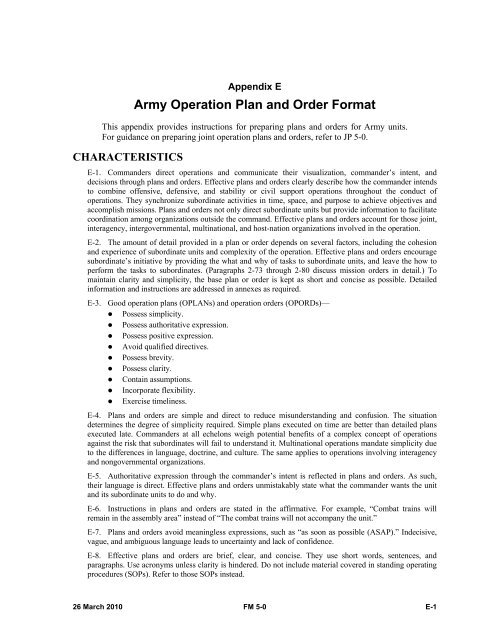FM 5-0, The Operations Process - Federation of American Scientists
FM 5-0, The Operations Process - Federation of American Scientists
FM 5-0, The Operations Process - Federation of American Scientists
You also want an ePaper? Increase the reach of your titles
YUMPU automatically turns print PDFs into web optimized ePapers that Google loves.
Appendix E<br />
Army Operation Plan and Order Format<br />
This appendix provides instructions for preparing plans and orders for Army units.<br />
For guidance on preparing joint operation plans and orders, refer to JP 5-0.<br />
CHARACTERISTICS<br />
E-1. Commanders direct operations and communicate their visualization, commander’s intent, and<br />
decisions through plans and orders. Effective plans and orders clearly describe how the commander intends<br />
to combine <strong>of</strong>fensive, defensive, and stability or civil support operations throughout the conduct <strong>of</strong><br />
operations. <strong>The</strong>y synchronize subordinate activities in time, space, and purpose to achieve objectives and<br />
accomplish missions. Plans and orders not only direct subordinate units but provide information to facilitate<br />
coordination among organizations outside the command. Effective plans and orders account for those joint,<br />
interagency, intergovernmental, multinational, and host-nation organizations involved in the operation.<br />
E-2. <strong>The</strong> amount <strong>of</strong> detail provided in a plan or order depends on several factors, including the cohesion<br />
and experience <strong>of</strong> subordinate units and complexity <strong>of</strong> the operation. Effective plans and orders encourage<br />
subordinate’s initiative by providing the what and why <strong>of</strong> tasks to subordinate units, and leave the how to<br />
perform the tasks to subordinates. (Paragraphs 2-73 through 2-80 discuss mission orders in detail.) To<br />
maintain clarity and simplicity, the base plan or order is kept as short and concise as possible. Detailed<br />
information and instructions are addressed in annexes as required.<br />
E-3. Good operation plans (OPLANs) and operation orders (OPORDs)—<br />
• Possess simplicity.<br />
• Possess authoritative expression.<br />
• Possess positive expression.<br />
• Avoid qualified directives.<br />
• Possess brevity.<br />
• Possess clarity.<br />
• Contain assumptions.<br />
• Incorporate flexibility.<br />
• Exercise timeliness.<br />
E-4. Plans and orders are simple and direct to reduce misunderstanding and confusion. <strong>The</strong> situation<br />
determines the degree <strong>of</strong> simplicity required. Simple plans executed on time are better than detailed plans<br />
executed late. Commanders at all echelons weigh potential benefits <strong>of</strong> a complex concept <strong>of</strong> operations<br />
against the risk that subordinates will fail to understand it. Multinational operations mandate simplicity due<br />
to the differences in language, doctrine, and culture. <strong>The</strong> same applies to operations involving interagency<br />
and nongovernmental organizations.<br />
E-5. Authoritative expression through the commander’s intent is reflected in plans and orders. As such,<br />
their language is direct. Effective plans and orders unmistakably state what the commander wants the unit<br />
and its subordinate units to do and why.<br />
E-6. Instructions in plans and orders are stated in the affirmative. For example, “Combat trains will<br />
remain in the assembly area” instead <strong>of</strong> “<strong>The</strong> combat trains will not accompany the unit.”<br />
E-7. Plans and orders avoid meaningless expressions, such as “as soon as possible (ASAP).” Indecisive,<br />
vague, and ambiguous language leads to uncertainty and lack <strong>of</strong> confidence.<br />
E-8. Effective plans and orders are brief, clear, and concise. <strong>The</strong>y use short words, sentences, and<br />
paragraphs. Use acronyms unless clarity is hindered. Do not include material covered in standing operating<br />
procedures (SOPs). Refer to those SOPs instead.<br />
26 March 2010 <strong>FM</strong> 5-0 E-1















